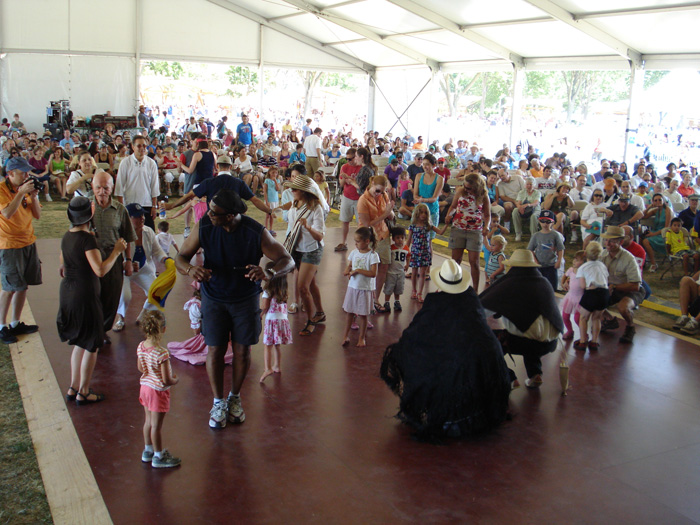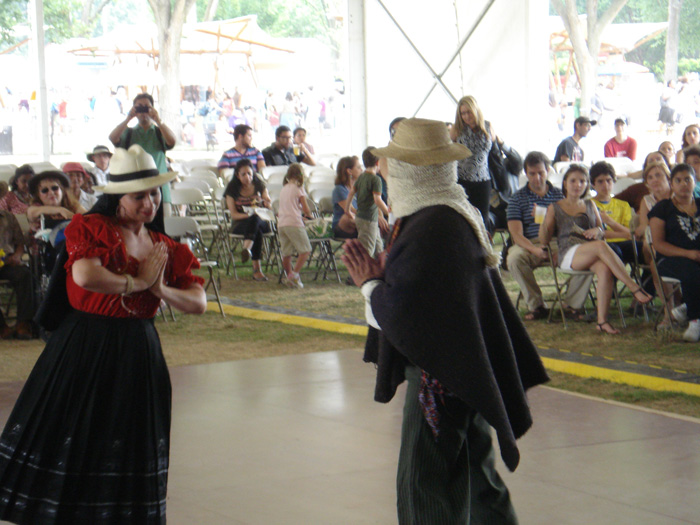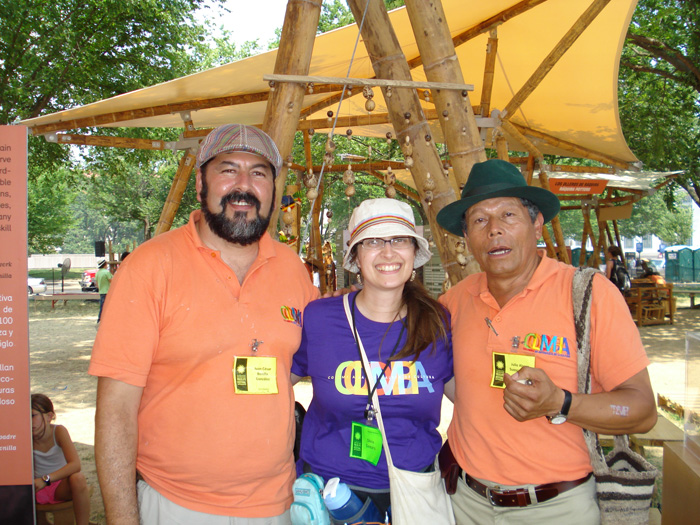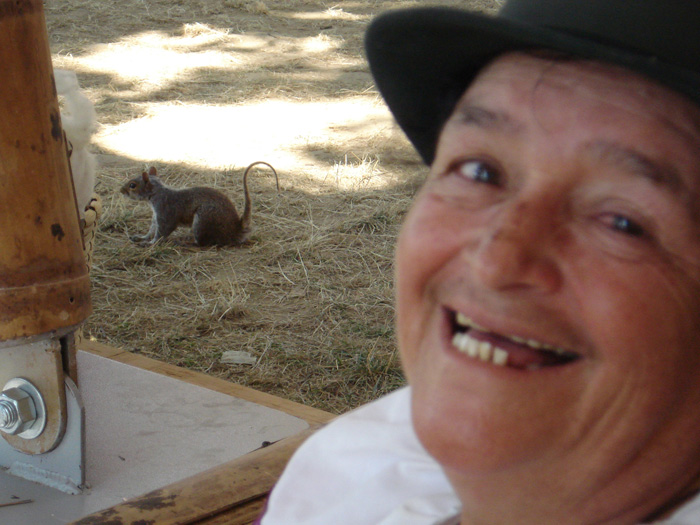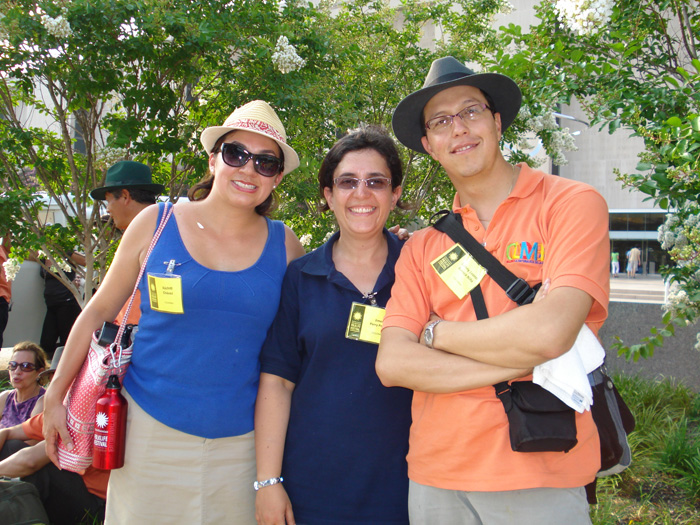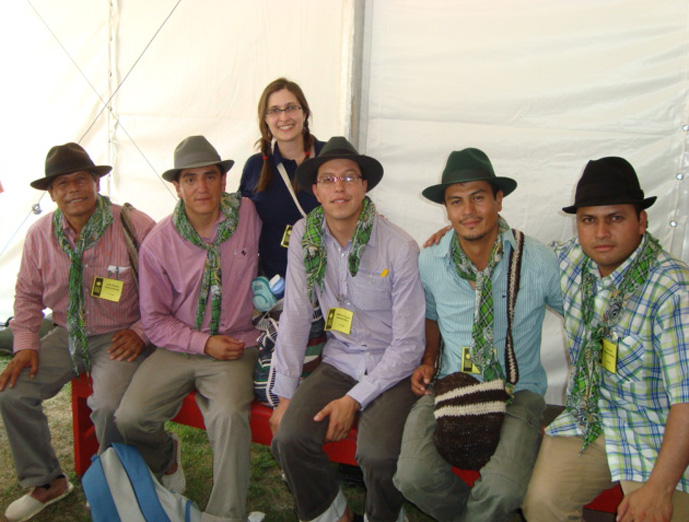Presenting at the Colombia Program: Contributing to Cultural Exchange

Colombia: the Nature of Culture program was a wonderful space where people from different parts of Colombia had the opportunity to share their practices and knowledge with the world. The Festival program took place in a country that welcomes countless of immigrants from different countries; and in a city, Washington D.C., that is also characteristically diverse. Furthermore, the broader Folklife Festival brought together people from different parts of the U.S. through the Rhythm and Blues program and from the world over through the Peace Corps program.
The festival facilitated an exchange of knowledge between participants and visitors. As people observed, met, and spoke with one another, they learned about their cultural differences and similarities. I had the pleasure to interpret a conversation between María Florinda Coy, a basket weaver from the highlands, and a woman from the U.S. who also weaves with natural fibers. Even without my translation, the two women were able to communicate as María Florinda "talked" with her hands and gestured her meanings. The other woman concluded: "She and I speak the same language."
What's more, the Festival put a human and personal face on Colombian culture. Colombia, for many visitors, is no longer simply an abstract point on the map, related only to drug trafficking or coffee and flower trading. Now, for them, Colombia is also the face of Enrique Hernández, his balsa wood fishes, and the Caquetá river where the fishes that inspire him live. Colombia is also the face of Juan César Bonilla, who artfully "discovers" and crafts objects from the seed of the tagua palm.
Thus, through the Festival, people from many different parts of the world had the opportunity to encounter and get to know a different face of Colombian culture. Meanwhile, Colombian people were able to explore their differences from and similarities with people from other parts of the world, and they learned more about the different cultures that comprise their own country. I think the Festival provided an invaluable experience for everyone involved. It is a wonderful event that contributes to increasing knowledge and understanding between different cultures.
Silvia Serrano received her master’s degree from Pennsylvania State University. Her thesis analyzed carranguera music lyrics as a space of cultural resistance over the traditional representations of campesinos from the Cundiboyancense highlands. She served as a presenter and interpreter at the 2011 Folklife Festival Colombia program.
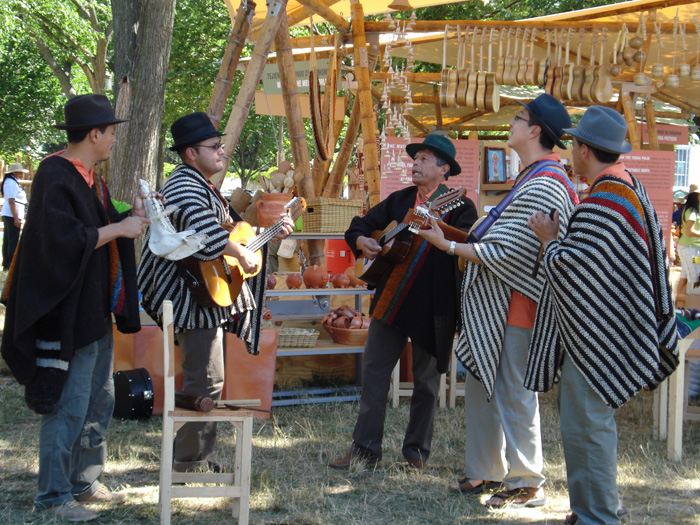
-
El Pueblo Canta playing next to the Tienda ChiquinquireñaPhoto by Silvia Serrano
-
Laura Jeanette Alba and Jorge Alberto Rodríguez, dancers from the cundiboyacense highlands, dance Jorge Velosa's La Gallina Mellicera interpreted by El Pueblo Canta, with children and adults.Photo by Silvia Serrano
-
Laura Jeanette Alba and Jorge Alberto Rodríguez dance the highlands traditional dance torbellino, interpreted by El Pueblo Canta.Photo by Silvia Serrano
-
Daniel Matapí Yucuna paints a flute, an instrument used in sacred Matapí ceremonies.Photo by Silvia Serrano
-
Two visitors paint and play the flutes built by Daniel Matapí Yucuna from the Amazonian ecosystem.Photo by Silvia Serrano
-
Uldarico Matapí Yucuna, a Matapí shaman from the Amazonian ecosystem, and a visitor exchange headwear.Photo by Silvia Serrano
-
Juan César Bonilla, tagua craftsman, Silvia Serrano, interpreter and presenter, and Álvaro Suesca, director of El Pueblo Canta.Photo by Carolina Satamaría
-
Ana Dolores Russi, wool weaver, enjoys watching a squirrel for the first time.Photo by Silvia Serrano
-
Presenters Xochitl Chávez and Jimena Perry with Danny Leonel Suesca, guitarist from El Pueblo Canta.Photo by Silvia Serrano
-
Members of El Pueblo Canta, from left to right, Álvaro Suesca, Giovanni Suárez, Danny Leonel Suesca, Edixon Suesca and Eduardo Vega with Silvia Serrano, interpreter and presenter.Photo by Daniel Serrano
Click on the image above to enlarge and view the gallery
EN ESPANOL
"Presentar en el programa Colombia: Una contribución al intercambio cultural"
Colombia: La naturaleza de la cultura fue un maravilloso espacio donde personas de diferentes partes de Colombia tuvieron la oportunidad de compartir sus prácticas y conocimientos con el mundo. El Festival tuvo lugar en un país que recibe a un sin número de inmigrantes de diferentes países, y en particular, en la ciudad de Washington D.C. que se caracteriza por su diversidad. Además, el Festival reunió a personas de diferentes partes de los EE.UU. a través del programa Rhythm and Blues, y de varios países a través del programa del Cuerpo de Paz.
El Festival propició el intercambio de conocimiento entre los participantes y los visitantes, Observando y conversando aprendieron uno del otro sobre sus diferencias y similitudes culturales. Tuve el placer de interpretar una conversación entre María Florinda Coy, una tejedora de canastas del altiplano, y una señora estadounidense que también tejía con fibras naturales. Durante la conversación, María Florinda habló con sus manos, y antes de que yo pronunciara las palabras, la señora entendió lo que María Florinda quería comunicar. La señora llegó a la conclusión: "ella y yo hablamos el mismo idioma."
Sobre todo, el Festival le puso un rostro a la cultura colombiana. Colombia, para muchos visitantes, ya no es un punto abstracto en el mapa, ni se asocia solamente al narcotráfico, el café o el comercio de flores. Ahora, para muchos visitantes del Festival, Colombia también es el rostro de Enrique Hernández, sus pescados tallados de balso y el río Caquetá, donde viven los peces que lo inspiran, o la cara de Juan César Bonilla, la palma de tagua y los objetos que descubre en sus semillas.
Así, a través del Festival, personas de diferentes partes del mundo tuvieron la oportunidad de ver y conocer una cara diferente de Colombia. Igualmente, los colombianos descubrieron diferencias y similitudes con personas de otras partes del mundo, y aprendieron más acerca de las diferentes culturas que conforman la gran cultura colombiana. Creo que la experiencia del Festival fue una ganancia invaluable para todos los involucrados. El Festival es un evento maravilloso y una gran contribución al conocimiento y el entendimiento entre diferentes culturas.
Silvia Serrano recibió su grado de maestría de Pennsylvania State University. En su tesis de maestría Silvia analizó las letras de la música carranguera como un espacio de resistencia cultural sobre las representaciones tradicionales de los campesinos del altiplano cundiboyacense. Ella fue presentadora e intérprete en el programa Colombia.


